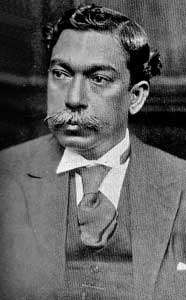E. W. Perera
Edward Walter Perera (11 December 1875 – 15 February 1953) was a Ceylonese (Sri Lankan) barrister, politician and freedom fighter. He was known as the "Lion of Kotte" and was a prominent figure in the Sri Lankan independence movement and a senator.
E. W. Perera | |
|---|---|
 | |
| Senator of Ceylon | |
| Personal details | |
| Born | 11 December 1875 |
| Died | 15 February 1953 (aged 77) |
| Nationality | Ceylonese (Sri Lankan) |
| Alma mater | Royal College Colombo |
| Occupation | Politics |
| Profession | Barrister |
Early life and education
Born on 11 December 1875 at Unawatuna, Galle to Edward Francis Perera, Proctor of Colombo and Johana Matilda, daughter of Mudliyar William David Perera Jayawickrema Seneviratne of Thalpaththuwa, Galle. Raised as a devoted Christian, Perera was educated at Royal College, Colombo and was the first editor of the Royal College Magazine. He served as a sub-editor of the newspaper Examiner while studying law at the Ceylon Law College and was called to the Bar as an Advocate in May 1900. Having gone to England for further studies in the Middle Temple, he became a Barrister in 1909. Perera was a member of the first Reform Deputation in 1910.[1]
Role in the independence movement
During World War I, in 1915 commercial-ethnic rivalry erupted into a riot in Colombo against the Muslims, with Christians participating as much as Buddhists. Fearing an uprising the inexperienced British colonial Governor of Ceylon Sir Robert Chalmers declared Martial Law on 2 June 1915 and on the advice of Inspector General of Police Herbert Dowbiggin began a brutal suppression of the Sinhala community by giving orders to the Police and the Army to shoot any one who they deemed a rioter without a trial, it is said the numbers of Sinhalese killed this way were thousands. Many local leaders, that included D. S. Senanayake, D. R. Wijewardena, Arthur V. Dias, Dr. Cassius Pereira, Dr. W. A. de Silva, F.R. Dias Bandaranaike, H. M. Amarasuriya, A.H. Molamure where imprisoned and Captain D.E.Henry Pedris, a militia commander, was shot for mutiny.
.svg.png)
A memorandum was drafted at a secret meeting held at the residence of E. W. Perera, initiated by Sir James Peiris with the participation of Sir Ponnambalam Ramanathan. Before presenting it to his majesties government, the support of the British members of parliament and the press in England had to be obtained. Sea voyage was dangerous due to the presence of German submarines, which attacked ships and destroyed them. Abandoning a promising career at the Bar, E. W. Perera undertook the task of going over to England by obtaining permission saying he was going to do some research in the British museum. To his advantage, the British treated him as a scholarly Christian Barrister rather than a national patriot. He was accompanied by George E. de Silva. In England, he was joined by Sir Ponnambalam Ramanathan and later by Sir D.B Jayatilaka and they presented the memorandum to the Secretary of State for the Colonies, pleading for the repeal of martial law and describing the atrocities committed by the Police led by Dowbiggin.[2] The mission was a success. The British government ordered the release of the leaders who were in detention. Several high officials were transferred. A new Governor, Sir John Anderson was sent to replace Sir Robert Chalmers with instructions to inquire and report to His Majesty's Government. E. W. Perera's effort was greatly appreciated and he was thereafter referred to as the Lion of Kotte.
It was also E. W. Perera who with the help of D. R. Wijewardena, the press baron (grandfarther of the current Prime Minister of Sri Lanka Ranil Wickramasinghe) traced the location of the banner of last King Sri Vikrama Rajasinghe, the last king of the Kingdom of Kandy to the Royal Hospital Chelsea where it was kept since the surrender of the Kingdom to the British in 1815. The recovered banner became a focal point in the independence movement and it became the flag of the Dominion of Ceylon upon its independence in 1948.[3]
Political career
He was a member of the Legislative Council – first as member from Western Province BH Division (1920) and then representing the Kalutara District (1924). As President of the Ceylon National Congress, he led its delegation before the Donoughmore Commission in 1926/27. Sincere to his convictions, he opposed the granting of universal adult suffrage and broke with his colleagues in the Congress. He agitated for full freedom and formed the All-Ceylon Liberal Association with Sir James Peiris. However, he was elected Member of the State Council for the Horana seat (1931) by a majority of 12,432 votes. He was a scholar and wrote several books. He died on 15 February 1953 at the age of 79.
See also
References
- Fernando, C W Annesley Sumith. "E W Perera, Lion of Kotte". Daily News. Retrieved 16 April 2020.
- Features
- Tribute to the men who gave us the National Flag